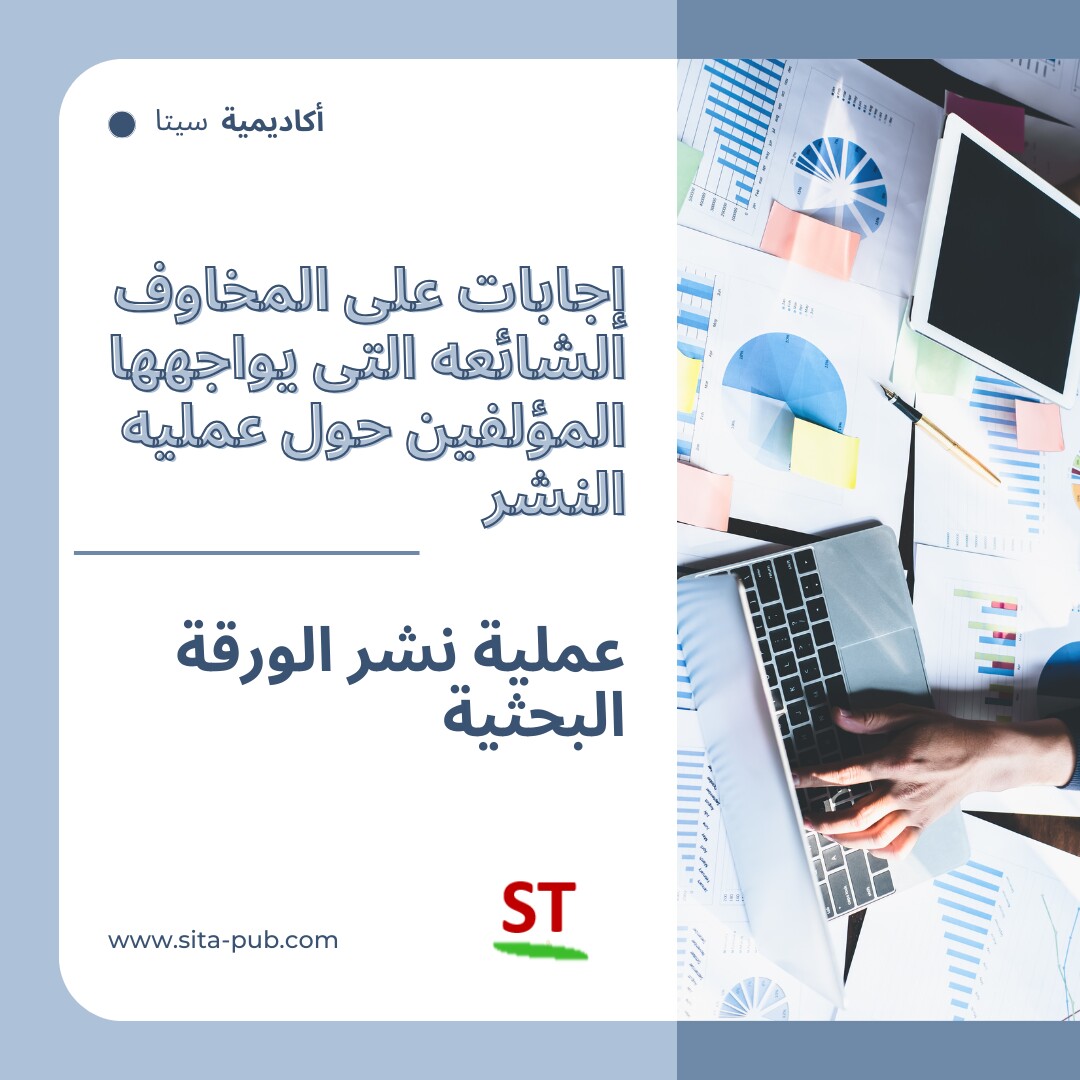إجابات على المخاوف الشائعه التی یواجهها المؤلفین حول عملیه النشر


نشر مخطوطه یمکن أن یکون رحله مرهقه للعدید من االمؤلفین، خاصه أولئک الجدد فی العملیه. هنا، نتناول بعض القلق الشائع الذی یواجهه الکتاب کثیرًا، ونقدم وضوحًا وإرشادات للتنقل فی منظر النشر.
أحد القلق الرئیسیه لالمؤلفین هو فهم عملیه النشر بأکملها. تشمل عاده عده مراحل رئیسیه: اختیار المجله، التنسیق، التقدیم، مراجعه الأقران، التعدیلات، القبول، والنشر.

نصیحه: قم بإنشاء جدول زمنی یوضح کل خطوه، بما فی ذلک المواعید النهائیه للتعدیلات وتواریخ التقدیم، لتبقى منظمًا.
یمکن أن یکون اختیار المجله المناسبه مرهقًا. غالبًا ما یشعر المؤلفین بالقلق حول مدى ملاءمه عملهم لنشر معین وکیفیه تقییم جوده المجله.
الحل: قم بالبحث بعنایه فی المجلات المحتمله. ابحث عن تلک التی تنشر أعمالًا مماثله لعملک. تحقق من معامل التأثیر للمجله، والقراءه، وإرشادات التقدیم.
نصائح للاختیار:
اقرأ العدد الأخیر: اطلع على أنواع المقالات المنشوره.
تحقق من خیارات الوصول المفتوح: قرر ما إذا کنت ترغب فی جعل عملک متاحًا بحریه.
قیم مقاییس المجله: ابحث عن معامل التأثیر ومعدلات الاستشهاد لتقییم الوضوح.
بمجرد اختیارک للمجله، الخطوه التالیه هی تنسیق مخطوطتک وفقًا لإرشاداتهم الخاصه. کل مجله لها متطلبات فریده بخصوص الهیکل، ونمط الاقتباس، والطول.
نصائح للتنسیق:
قم بتنزیل القوالب: توفر العدید من المجلات قوالب تبسط عملیه التنسیق.
أنشئ قائمه تدقیق: تأکد من تضمین جمیع العناصر المطلوبه، مثل صفحات العنوان، والملخصات، والکلمات الرئیسیه.
استخدم برامج إداره المراجع: یمکن أن تساعدک الأدوات مثل EndNote أو Mendeley فی إداره الاقتباسات وتنسیق المراجع بشکل صحیح، ولکن من المهم ملاحظه أن EndNote عاده ما یتطلب اشتراکًا مدفوعًا، بینما یقدم Mendeley نسخه مجانیه بمیزات محدوده، بالإضافه إلى خطط مدفوعه لمساحه تخزین إضافیه ووظائف.
بعد التنسیق، قم بإعداد مخطوطتک للتقدیم. ینطوی هذا عاده على إنشاء حساب على منصه تقدیم المجله وتحمیل الوثائق المطلوبه.
نصائح للتقدیم:
تحقق مرتین: تأکد من أن جمیع الملفات مهیأه بشکل صحیح ومسماه بشکل صحیح.
اکتب رساله تغطیه مقنعه: قدم عملک، واشرح أهمیته ولماذا یتناسب مع نطاق المجله.
قدم مبکرًا: لا تنتظر حتى اللحظه الأخیره للتقدیم؛ فهذا یتیح الوقت لمعالجه أی مشاکل غیر متوقعه.
بعد التقدیم، ستخضع مخطوطتک للمراجعه النظیریه. ینطوی هذا العملیه على إرسال عملک إلى خبراء فی مجالک الذین سیقومون بتقییم جودته وصلته. قد یشعر الکتاب بالقلق بشأن تلقی تغذیه راجعه نقدیه أو إمکانیه الرفض.
توضیح: یستغرق عملیه المراجعه النظیریه عاده أسابیع أو حتى أشهر. توقع انتقادات بناءه تهدف إلى تحسین عملک.
نصائح لمرحله المراجعه النظیریه:
کن صبورًا: یمکن أن تستغرق عملیه المراجعه وقتًا.
کن مستعدًا لملاحظات الراجعه: قد یقدم المراجعون انتقادات بناءه یمکن أن تحسن مخطوطتک.
استعد للتعدیلات: تتطلب معظم المخطوطات تعدیلات استنادًا إلى تعلیقات المراجع.
التعامل مع الملاحظات الراجعه
إذا تم إعاده مخطوطتک مع طلبات للتعدیلات، فخذ الملاحظات الراجعه على محمل الجد. هذه المرحله حاسمه لتحسین عملک وزیاده فرص قبوله.
نصائح للتعدیل:
أنشئ وثیقه رد: تناول کل تعلیق من المراجعین بشکل منهجی.
کن دقیقًا: أظهر أنک قمت بتغییرات کبیره أو قدم مبررات لأی اقتراحات اخترت عدم تنفیذها.
ابحث عن ملاحظات راجعه: افکر فی طلب من زملائک مراجعه تعدیلاتک قبل إعاده التقدیم.
بمجرد اکتمال التعدیلات، قد یتم قبول مخطوطتک للنشر. هذه خطوه مثیره، ولکن قد تبقى بعض الخطوات.
نصائح لمرحله القبول:
استعرض رساله القبول: اقرأ بعنایه أی تعلیمات بخصوص التعدیلات النهائیه أو البراهین.
فهم قضایا حقوق النشر: کن على علم باتفاقیات نقل حقوق النشر وحقوقک ککاتب.
استعد للمهام بعد القبول: قد تحتاج إلى تقدیم الملفات النهائیه أو استکمال نماذج إضافیه.
یتوج عملیه النشر بإصدار عملک النهائی. قد ینطوی ذلک أولاً على النشر عبر الإنترنت، تلیه النشر الورقی.
نصائح لمرحله النشر:
قم بالترویج لعملک: بمجرد النشر، شارک أبحاثک عبر وسائل التواصل الاجتماعی، والشبکات الأکادیمیه، وجهات الاتصال الشخصیه.
تفاعل مع القراء: استجب للاستفسارات أو المناقشات التی تنشأ من نشرک.
راقب التأثیر: استخدم أدوات مثل Google Scholar لتتبع الاقتباسات والتفاعل مع عملک.
الرفض هو جزء شائع من رحله النشر، ولکن یمکن أن یکون محبطًا. غالبًا ما یشعر الالمؤلفین بالقلق حول کیفیه التعامل مع الرفض وما إذا کان یعکس جوده عملهم.

الحل: فهم أن الرفض لیس شیئًا نادرًا؛ حتى الالمؤلفین الذین لدیهم خبره یواجهونه. استخدم الرفض کتجربه تعلم. قم بمراجعه الملاحظات الراجعه المقدمه وقم بمراجعه مخطوطتک وفقًا لذلک.
نصیحه: افکر فی تقدیم عملک إلى مجله أخرى قد تکون أفضل، أو خذ وقتًا لتنقیح مخطوطتک استنادًا إلى الملاحظات الراجعه التی تلقیتها.
یمکن أن تنشأ مخاوف حول حقوق النشر والأذونات، خاصه فیما یتعلق باستخدام المواد من جهات خارجیه مثل الصور، والجداول، أو الاقتباسات الطویله. یجب على الالمؤلفین التأکد من أن لدیهم الحق فی استخدام مثل هذه المواد فی نشرهم.

الحل: تعرف على قوانین حقوق النشر وعملیه الأذونات. إذا استخدمت محتوى من جهه خارجیه، احصل على الأذونات اللازمه قبل التقدیم.
نصیحه: افکر فی استخدام مواد مرخصه بموجب Creative Commons عندما یکون مناسبًا، حیث یسمحون فی کثیر من الأحیان بإعاده الاستخدام بسهوله.

هل أنت مستعد للمضی قدمًا فی رحلتک فی النشر؟ تقدم أکادیمیه سیتا مجموعه من الخدمات، بما فی ذلک تحریر النصوص باللغه الإنجلیزیه الأصلیه، إعاده صیاغه النصوص، فحص الاقتباسات، تنسیق الورقه البحثیه، ومساعده فی التقدیم مع متابعه مستمره. دعنا نتولى التفاصیل التقنیه حتى تتمکن من الترکیز على بحوثک. انضم إلى أکادیمیه سیتا الیوم وحول أهدافک فی النشر إلى واقع!
لماذا تختار أکادیمیه سیتا؟

فریق من المحترفین البشر

ضمان الجوده

التسلیم فی الوقت المحدد

ضمان الرضا